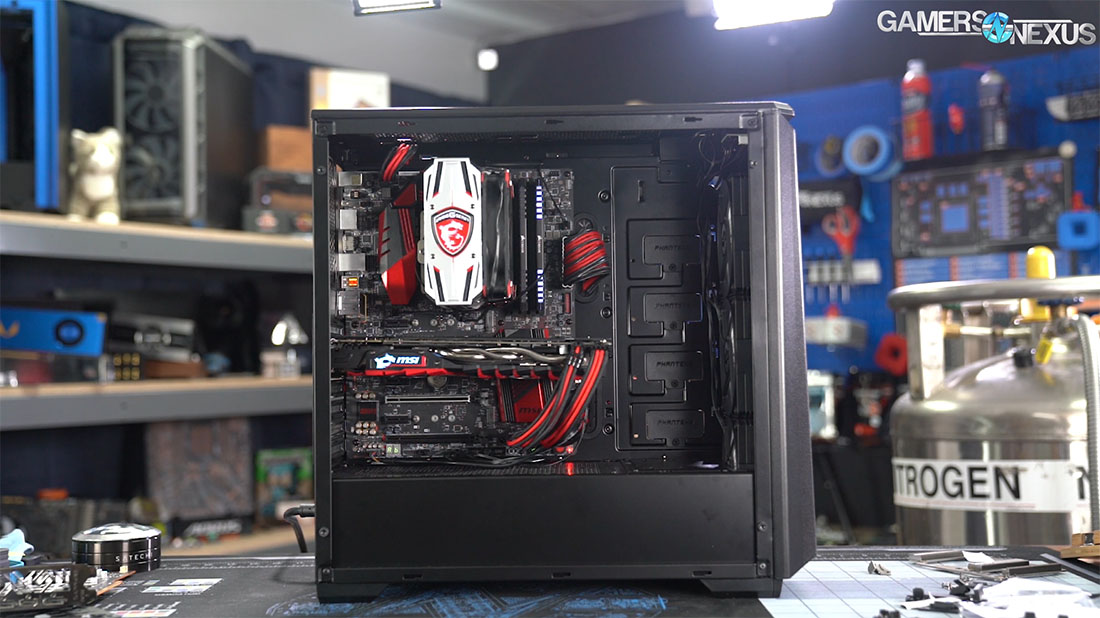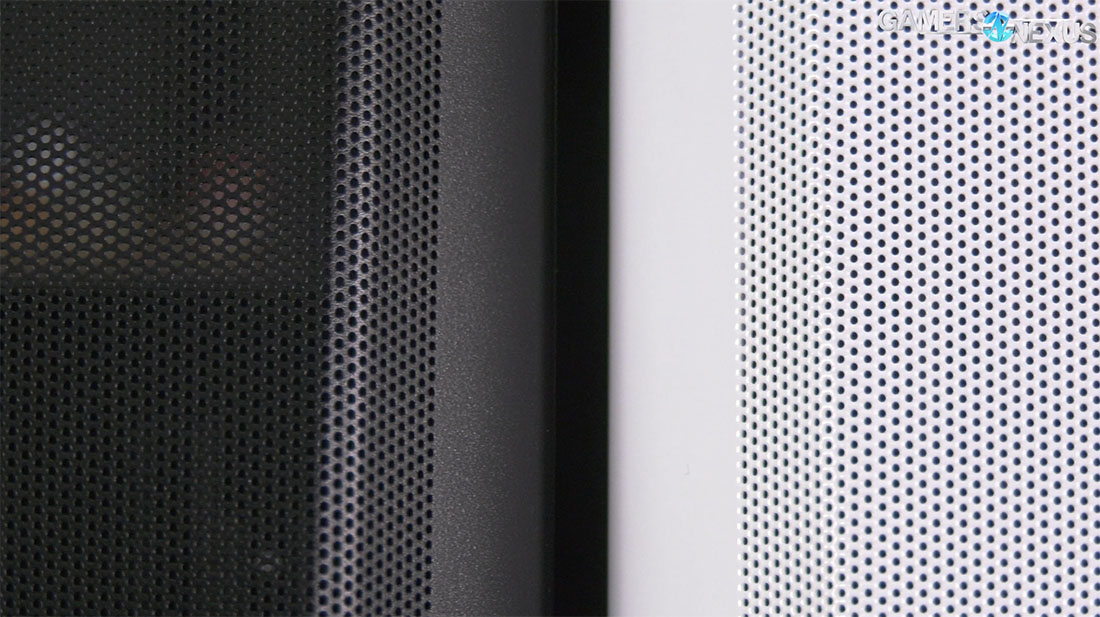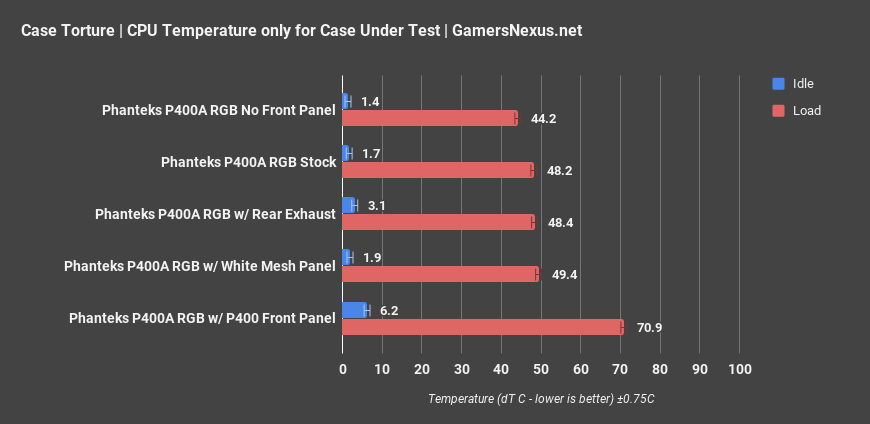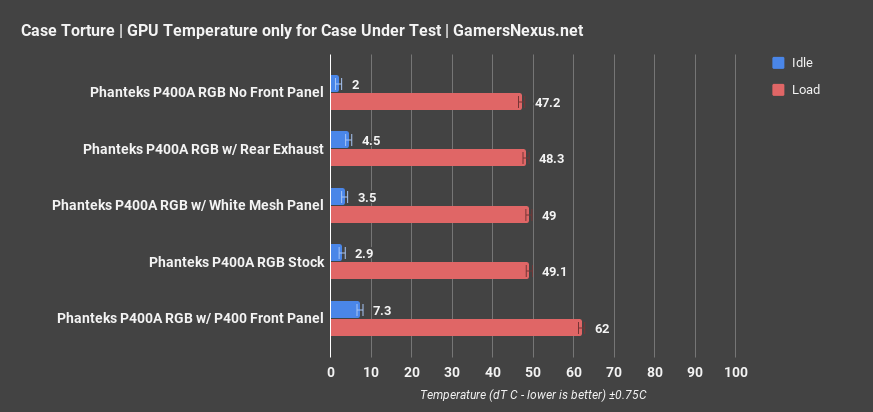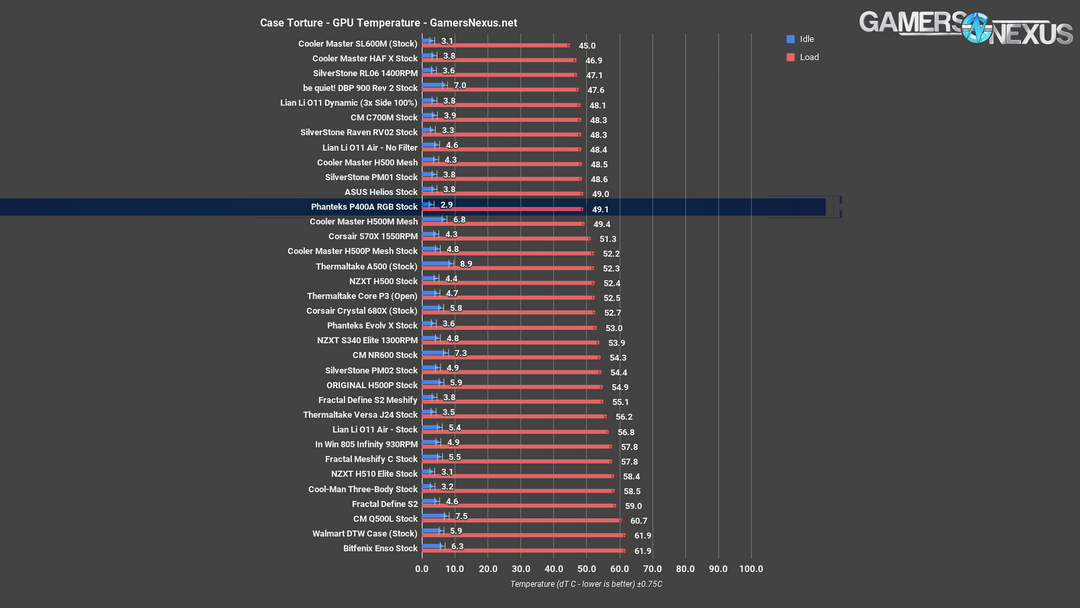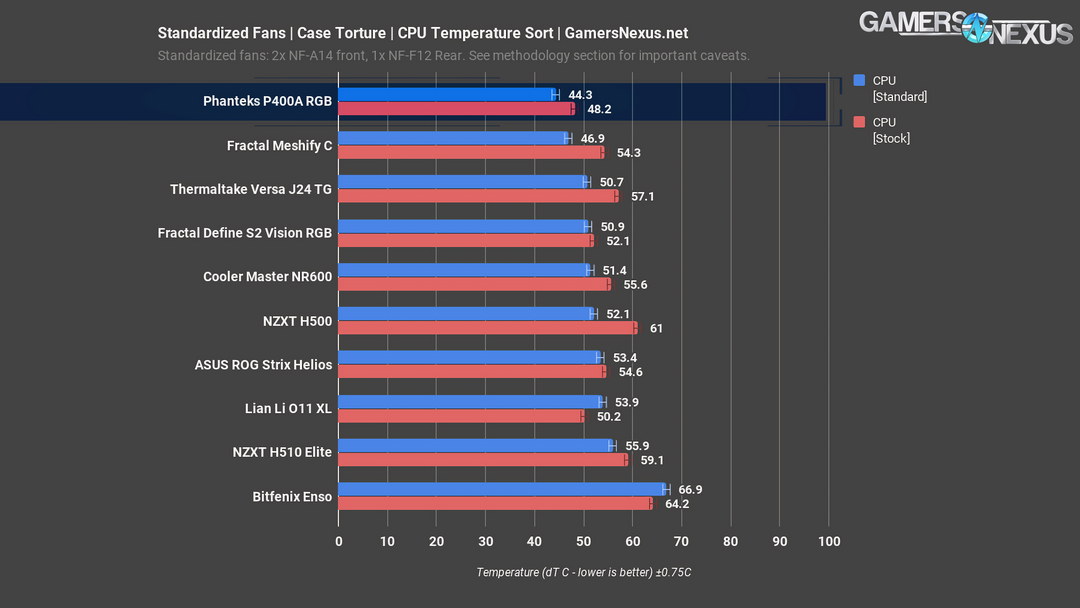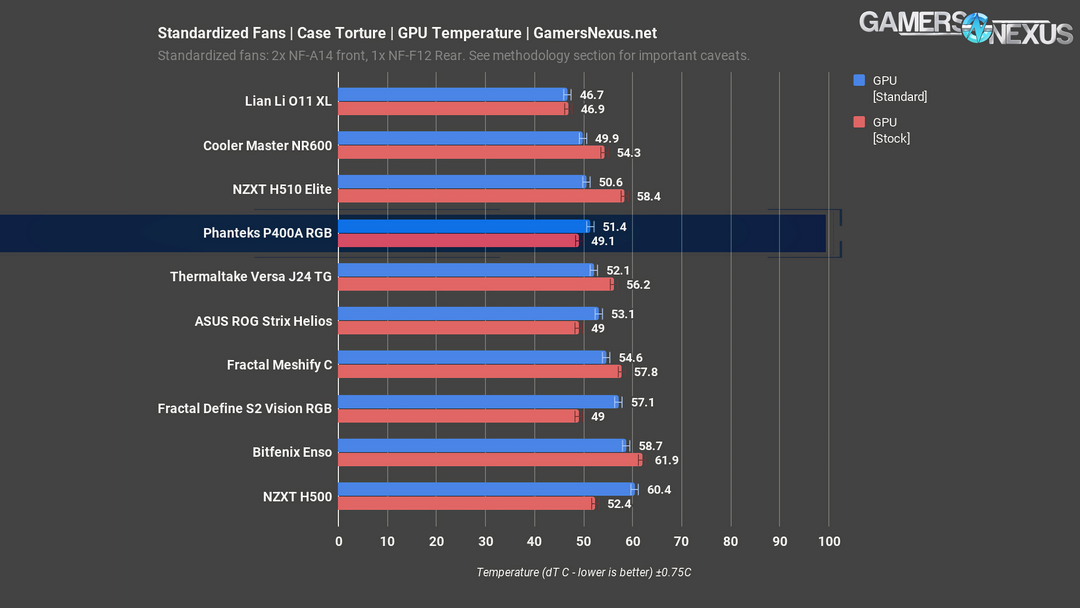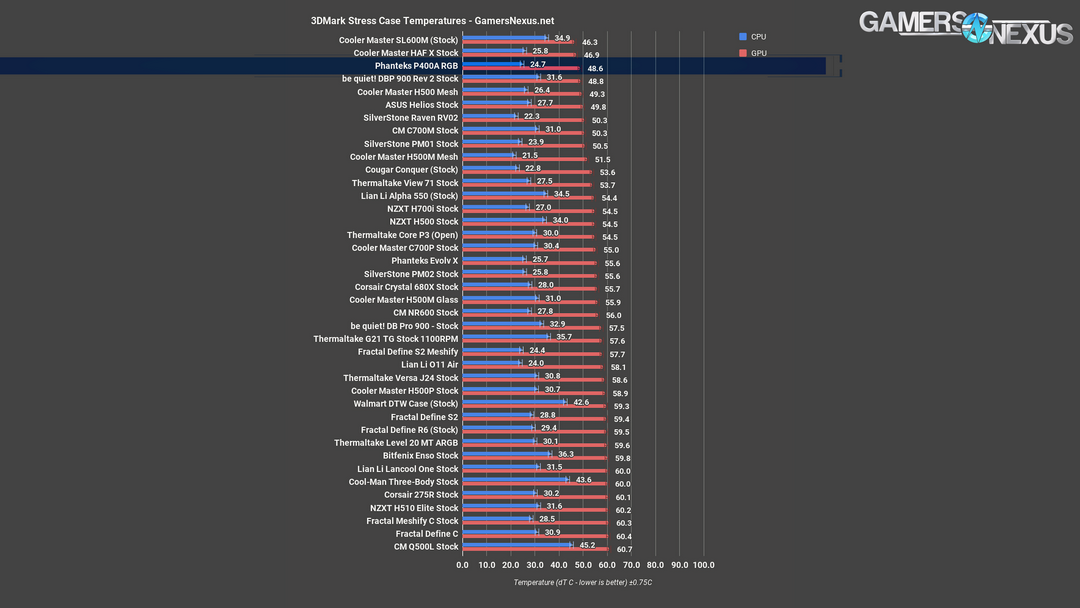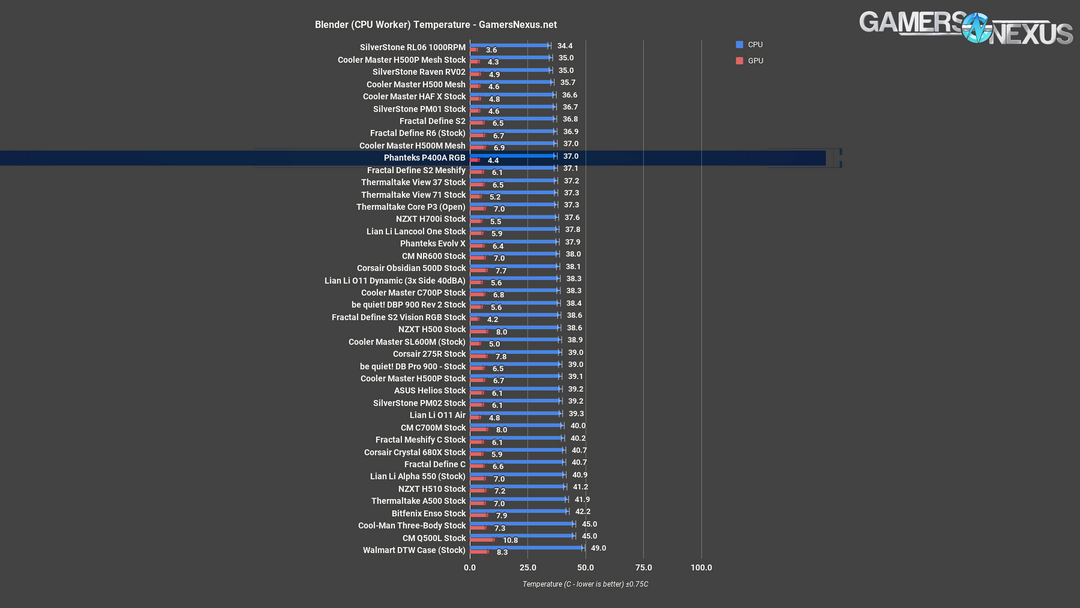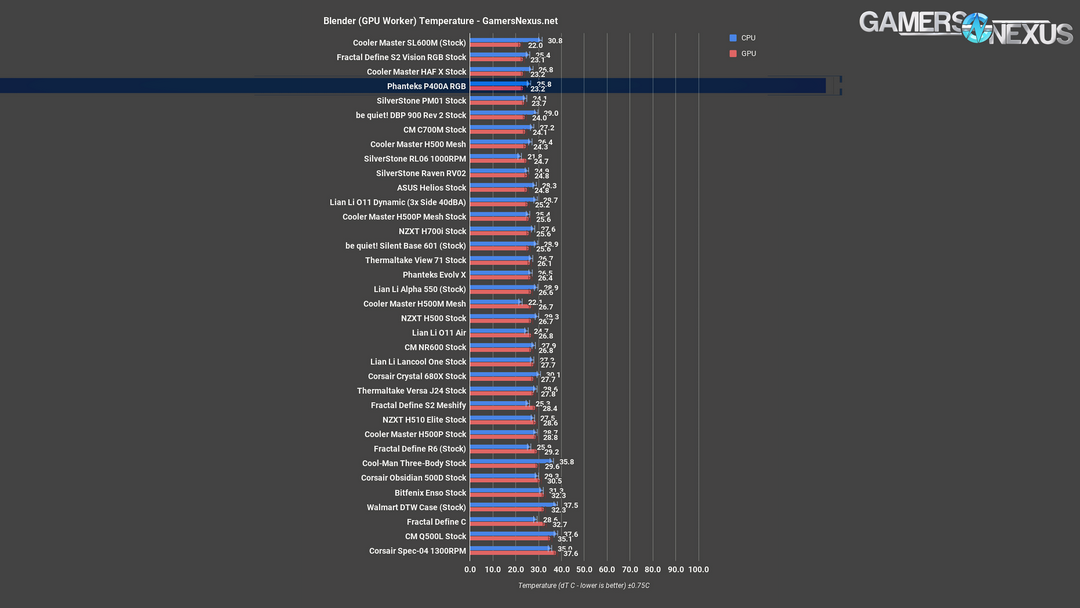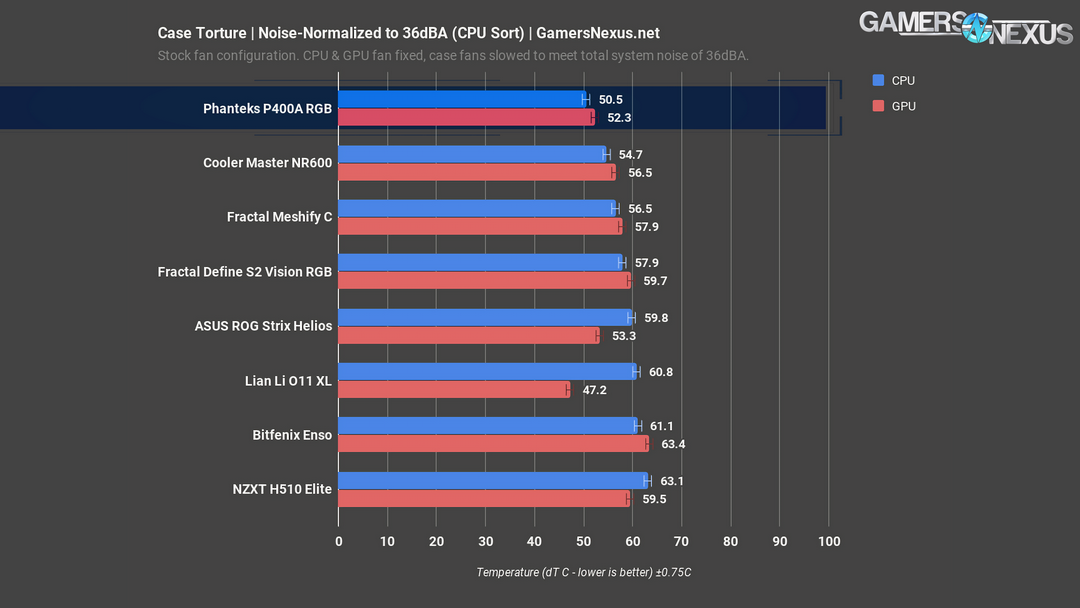The Phanteks P400A gave us tentative hope at Computex when we saw its move to a fine mesh front panel, similar to what Cooler Master did with the NR600. The P400A follows-up on the original Eclipse P400, but while keeping the base tooling, it massively overhauls the panel design to move away from a closed-off, suffocated front and toward a more open mesh. Phanteks also avoids the trap that many fall into by eliminating a dust filter, instead relying on the fine mesh as a filter and keeping airflow as open as possible. In today’s testing, we’ll look at the Phanteks P400A RGB for thermals and acoustics, but we’ll also test the white panel versus black panel to see if the paint thickness matters, then throw the original P400 panel on for comparison.
The original Phanteks Eclipse P400 released circa 2016. The P400 is a case that launched during the initial explosion of S340-esque cases with sealed front panels, full-length PSU shrouds, and no optical drive support. Phanteks has gotten an impressive amount of use out of that tooling over the years, most recently with the case we’re reviewing today: the mesh-fronted P400A that comes as a $70 base model with two fans and a fan controller or a $90 RGB model with three fans and an LED controller. We’ll be covering the $70 model in a separate piece, since this review is already full to the brim with testing of the P400A’s front panel.
Phanteks P400A PC Build Quality
The P400 is an extremely basic case, of a type that has only gotten more common since we reviewed it the first time more than three years ago. The RGB model costs a bit more than the non-RGB option and empty mounts for HDD bays are sold separately, but at this point, this is no longer an unusual way to market PC cases and Stockholm syndrome has started to set in. The P400A RGB technically has ARGB LEDs on the fans and power button and is technically called the P400A_D (for digital) or super-duper-extra-technically the PH-EC400ATG_DBK (black) and PH-EC400ATG_DWT (white). We’re going to call it the P400A RGB instead.
There’s approximately 2.5cm between the motherboard tray and the steel side panel. Whether the P400A’s approach of a decent amount of clearance across the whole motherboard tray with some built-in velcro straps or the Meshify C’s approach (for example) of a narrow but deeper cable management space is a matter of user preference. The lack of a cable management bar does mean the P400A can fit E-ATX boards, since the motherboard tray is flat all the way to the front of the case--Phanteks only claims support for boards up to 272mm wide, but that’s due to a lack of mounting holes at the front of the case and conflict with the optional HDD mounts. Some modification and creative cable routing might allow for even wider boards.
The RGB controller in the $90 model controls the LEDs of the three 120mm front fans and the power button, and has external mode and color controls on the front panel. The P400A accepts control via a 5V D-RGB motherboard header, as opposed to the 12V RGB header found in the older P400S. Again, we’ll save most coverage of the non-RGB P400A for another piece, but we can reveal that the LED and non-LED fans are identical in form and close enough in RPM to be considered within manufacturing variance.
Front panel items other than LED or fan controls include two USB 3.0 ports, audio in, audio out, and power/reset buttons. All of this is fully contained within the chassis and leaves the front panel free to pop off very conveniently. This would be more helpful on a case with a removable filter that needed to be cleaned, but it’s still appreciated since the majority of our testing required removing and replacing the front panel. Rear expansion slots consist of a big hole in the case with normal PCIe slot covers over it. The lack of crossbars to get in the way makes the P400A natively compatible with Phanteks’ vertical GPU mounting kit, which they sent us along with the case but which we didn’t get around to testing.
Construction is of fairly thin steel with a lot of flex in heavily-vented sections like the top of the PSU shroud and the top panel, but nothing terrible for a $70 case. Some of the rivets weren’t hammered completely flush with the chassis behind the front panel, but nothing was loose. That’s about all we have to say on the subject of the chassis--it’s a completely normal enclosure for the price, and we’ve already reviewed it once.
Phanteks P400A Panel Testing
On to the part that’s actually interesting: the front panel. There’s been some discussion in the community about whether the white variant of the case has worse airflow than the black variant, since the white one has a thick layer of enamel painted over the panel that appears to reduce the diameter of the ventilation holes. Hole diameter is about 1.19mm, as we’re able to fit a 3/64-inch drill bit cleanly into it, while the black panel [xxxxx]. We were initially sent the RGB case for review, but we also asked for a non-RGB SKU as well as a white front panel and a sealed front panel from an original P400, despite our published opinions on the older case. Because we kept requesting more panels and because of some unimportant but deeply frustrating complications with testing, this review has taken far longer to complete than we’d planned.
A side-by-side comparison reveals that the edges of the holes in the black panel are sharp and defined, while the edges of the holes in the white panel are rounded in a way that suggest a thick layer of paint. Each hole is about a millimeter in diameter, so it’s entirely plausible that a slightly reduced diameter across thousands of holes -- more than present here -- could measurably decrease airflow. The hole spacing also appears to be very slightly different on the two mesh black panels we have to work with: the P400A RGB one that we used for these tests matches the white panel exactly, while the non-RGB panel doesn’t quite line-up due to tighter hole spacing. We’d normally ignore that kind of manufacturing variance completely, but it’s worth mentioning when we’re already considering the kind of difference that a layer of paint might make.
We requested the old P400 panel as well because that’s the real benchmark for the P400A: how much better it performs than its sealed-off predecessor. We couldn’t simply seal off the vent holes in a P400A front panel because the P400 actually has filtered ventilation strips at the top and bottom that aren’t present in the P400A, so that air will be directed through the front panel instead of behind the top and bottom of the panel as it was in the older case. The P400A has no filters at all, and we like to see this on cases with fine mesh fronts--plenty of dust gets caught in the external grille, and adding another layer of filtration behind it only serves to kill airflow and defeat the purpose. The old P400 has bad airflow, and the new front panel design of the P400A is the reason we chose to review it in the first place.
We used the RGB model as the platform for our panel testing, since it has three intake fans situated directly behind the front panel. It’s not a P400 and the fan arrangement is different, so the scores with the P400 front panel should be taken as just that--scores for the P400 front panel, not the whole case.
Phanteks P400A Thermals & Noise
Along with the normal tests and the tests with alternate front panels, we also ran a pass with an added exhaust fan, like we usually do. We took one of the nearly-identical fans from the non-RGB P400A for a total of four fans, three intake and one exhaust. For this particular case, we validated testing 3 additional times beyond our norm to ensure accuracy, so it has been through the ringer and been validated heavily. As always, all fan speeds and all voltages are controlled manually to ensure that each test is without variables imposed by the system.
CPU TORTURE
We’ll start CPU thermals with just the Phanteks P400A, then we can move on to comparative results versus other cases.
In the P400A RGB, average CPU temperature in the torture test was 48.2 degrees Celsius delta T over ambient, with a relatively minor reduction down to 44.2 degrees from removing the front panel. We see much larger reductions in temperature when we take off non-mesh front panels, or even some of the more restrictive mesh panels like the Versa J24, shown in a separate review. That’s good news for the P400A, as it means it’s not hindering airflow at the top of the case any more than is reasonable; there will always be some hindrance without going full open bench, and a 4-degree swing is one of the best results we’ve seen for a panel removal test. This is completely reasonable and shows the fine mesh is doing its job. Putting the white mesh front panel on raised CPU temperature just a little more than 1 degree Celsius, up to 49.4C dT; although this could indicate some minor restriction of airflow due to the paint, it’s not enough to matter from a CPU cooling perspective, and it’s also close enough to be test variance. The test with the extra exhaust fan was surprisingly within margin of error of the original CPU torture result, so it seems that the three intake fans do a good enough job of pushing air through the case that our tower cooler didn’t need any extra help, but be mindful that this will vary based upon CPU cooler selection. The rear exhaust fan causes idle temperature to marginally increase as a result of pulling radiative heat off of the GPU backside through the CPU tower cooler. Putting the original P400 panel on revealed that, yes, mesh front panels do work: the CPU averaged 70.9 degrees Celsius over ambient, managing to maintain its frequency for most of the test but with a brief dip when the chip hit 100 degrees Celsius actual temperature. We’re not here to dunk on the original P400 again, just to point out that the P400A is a definite improvement, especially since we’re seeing some thermal throttling from the P400 panel.
On to the comparative results next: We have over 200 rows of case testing data in our spreadsheet, but we’ve narrowed it to this selection for the review. 48.2 degrees over ambient ties the P400A with the Cooler Master H500P Mesh (at 48.2 degrees) and puts it in the neighborhood of other well-received mesh cases with plenty of stock intake fans, like the old Silverstone PM01 and RL06 models. Performance is also similar to the CM NR600 with one fan added, which lands at 47.1 degrees; we mention this result as the two are similar in price, but they also use very similar fine mesh approaches. The stock Meshify C and Meshify S2 are both significantly warmer at 54.3 degrees and 50.7 degrees Celsius dT over ambient, respectively, thanks to the lower count of intake fans, while the Meshify C with added Noctua intake fans is back in the same neighborhood of the P400A at 47.3C dT. Our tests of the original P400 predate this test bench and these results, but based on the results of the previous torture test, we know the P400A strongly outperforms it. Typical closed-front cases like the NZXT H500 and H510 Elite are potential stand-ins for the P400 here, in that they’re more than 10 degrees warmer than the P400A in CPU dT.
GPU TORTURE
Back to the P400A only, the GPU temperature averaged 49.1 degrees Celsius dT in the torture test, with even less improvement than the CPU from removing the front panel, down to 47.2 degrees Celsius over ambient. The heavy ventilation of the PSU shroud means that the lowermost intake fan isn’t completely wasted, and some of the cool air it draws under the shroud can work its way into the body of the case. PSU shrouds are great for keeping cables hidden, but they often limit the usefulness of fans in the lower quarter of the case to cooling HDDs (we always orient the PSU so it draws air from under the case). The result with the white panel was identical to the baseline result with the black panel, which tips the scale further towards the two panels being effectively the same, or minimally within measurement error of any real-world test components. The extra exhaust fan may have helped the GPU somewhat with an average dT of 48.3 degrees dT, but that’s still within test error and variance. Finally, the P400 front panel is again vastly worse than any other result we got in this case, measuring 62 degrees over ambient, so it’s throttling and hitting the maximum temperature before hard clock drops. The tiny vents at the top and bottom of the panel are nothing compared to the full mesh coverage directly in front of the intake fans.
On to the comparative chart. GPU temperature is less competitive for the P400A compared to our other cases than the CPU temperature was, but that’s mostly thanks to some unconventional cases like the SL600M having exceptionally good GPU cooling. The P400A still ranks alongside the Cooler Master H500 Mesh (at 48.5 degrees -- that’s the $100 variant) and the PM01 on our chart, while the stock Meshify S2 (55.1C dT) and Meshify C (57.8C dT) were a good deal warmer. Again, that’s not an inherent flaw of those cases, they just don’t have three stock intake fans pushing a wall of air. 49.1 degrees dT is a good GPU temperature for this test--it just can’t compare to the cases that have intake fans directly aimed into the GPU cooler.
STANDARDIZED FANS
The standardized fan benchmark is still fairly new to our test lineup--this is where we test each case with the same fans at the same speed and in the same location in what we consider a standard configuration, to see how chassis compare without stock fans as part of the equation. As a reminder, this testing is imperfect in its own ways, but is useful for comparing similar cases. We detailed the methods in a separate video on standardized fan testing. We placed two 140mm Noctua fans in the front intake mounts above the PSU shroud (140mm fans can’t be mounted below the level of the shroud) and one 120mm Noctua fan in the exhaust slot at the rear of the case. CPU dT averaged 44.3 degrees, the best result we’ve attained so far in our much more limited table for this test, ranking a couple degrees below even the 46.9 degrees dT average of the Fractal Meshify C. When we started standardized fan testing, we picked the Meshify C and the Bitfenix Enso as “good” and “bad” cases that would let us know what kind of range we could expect in our results, and now we’ve already blown past our “good” example.
GPU dT averaged 51.4C dT in the standardized fan test, slightly worse than baseline thanks to less incoming air along the bottom of the case, but still competitive compared to the other standardized fan results. This is an example of where the stock configuration performs better. The Lian Li O11 XL did better because we were forced to place intake fans directly under the GPU, and the similarly mesh-fronted Cooler Master NR600 did slightly better as well, though with a standard placement. The NZXT H510 Elite also was within error of the P400A, although it certainly wasn’t with NZXT’s stock fans installed.
3DMARK
3DMark Firestrike gives us another test, this one focused on real-world gaming performance. The 3DMark results are always fairly close to the torture results for GPU dT, and the P400A is no exception with an average GPU temperature of 48.6 degrees Celsius over ambient. That’s one of the better results we’ve seen, still keeping pace with the $100 H500 Mesh (at 49.3C) and now outscoring the PM01 (at 50.5). The stock Meshify C and Meshify S2 scored 60.3 and 57.7 degrees, respectively.
BLENDER
The blender CPU render averaged 37 degrees on the CPU, a couple degrees worse this time than the 35.7 degrees dT H500 Mesh and 36.7C PM01, but closer to the stock Meshify S2 for once. It’s still decidedly on the cooler side of the chart, but in a test that exclusively stresses the CPU, the P400A seems to lose some of the advantage that its good GPU cooling gives it in other tests.
The GPU-accelerated render averaged 23.2 degrees Celsius dT on the GPU, placing the P400A in a chart position much more in line with the other tests. The PM01 and even the HAF X scored results in this neighborhood. The 25.8C dT average for the CPU during this test is also relatively low, although the PM01 and RL06 did maintain better temperatures.
NOISE + NOISE NORMALIZED
Acoustic testing is next. At full fan speeds for the Phanteks fans, the P400A measured 38.6dBA, surprisingly quiet for a mesh-fronted case with three 120mm fans running at approximately 1300RPM separated from the user by a perforated metal screen and nothing else. Getting the case down to our 36dBA threshold for noise-normalized testing only required turning the case fans down to 75% speed in BIOS, or approximately 900-1000 RPM as logged by external measurement tools.
Noise-normalized results are up now: The speed reduction resulted in a CPU dT of 50.5 degrees over ambient, impressively close to the baseline temperature. That’s handily the best noise-normalized result on our limited, new chart so far, with the NR600 in second place at 54.7C dT.
GPU dT at 36dBA averaged 52.3 degrees, again fairly close to the baseline and again cooler than most of the other noise-normalized cases. The O11 XL did win out here, but that’s with Noctua 140mm fans added directly below the GPU (the ones from the standardized fan test) since the O11 XL doesn’t ship with any fans at all. Completely stock, the P400A is the best noise-normalized performer on the chart so far, although the chart consists of six other cases excluding the O11 XL.
CONCLUSION
The P400A RGB (or P400A_D officially) has an MSRP of $90 and is actually available for $90 from most retailers, with a white version similarly available. That’s the price range where many such tempered glass/mesh fronted cases are (the Meshify C) or should be (Versa J24, RL06 TG). The Cooler Master H500 is also good competition. Buyers should be aware that this is a fairly basic chassis without the sturdy construction or extra features (removable radiator mounts, for example) that a more expensive case would have, but it’s a fair price for what it is. Anyone that doesn’t care about RGB LEDs or would choose to replace the stock fans should stay tuned for our coverage of the P400A non-RGB, which is $20 cheaper and comes with one fewer fan.
As far as the front panel, it’s a vast improvement over the P400 we reviewed years ago. It’s simple, there are no extra layers of filtration stuffed in, and it allows both air and RGB lighting effects through freely. Using a fine metal mesh as a combined front panel and filter is good. It won’t stop dust as effectively as a “real” filter, but given a choice we much prefer a single layer of perforated metal to a decorative mesh panel backed by a foam or fabric filter. White or black doesn’t make enough difference to matter, although the black panel did perform very slightly better in our testing.
The direct competition for this case is obviously Fractal’s Meshify line. The differences to consider (other than price and compatibility with parts) are the number of fans included, the RGB LEDs in the P400A_D, Fractal’s insistence on using that weird faceted front panel design for every Meshify case, and any additional case features that Fractal may offer--we like Fractal’s cases, and they generally come well-equipped. The reason the P400A_D performs better than Fractal’s stock cases is down to the fans included with the case--ignoring those, they’re on the same footing. Check back for our review of the $70 P400A non-RGB, which uses the same fan arrangement as Fractal’s Meshify cases.
Editorial, Testing: Patrick Lathan
Test Lead, Host: Steve Burke
Video: Josh Svoboda, Andrew Coleman
